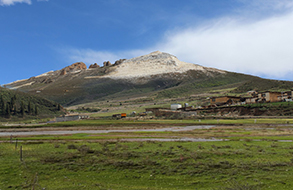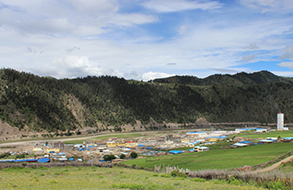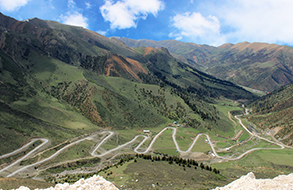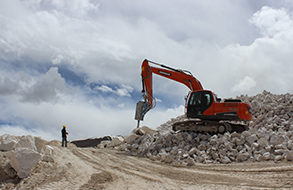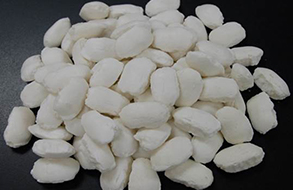High grade magnesite secures advanced magnesia-based refractories
----Interview with Shi Daoming
General Manager from Raw Material Department
PRCO
- Located in Minhe Industrial Zone within Haidong Industrial Park in Qinghai, PRCO Qinghai High-Tech Material Co., Ltd. (hereinafter referred to as PRCO Qinghai) mainly produces caustic calcined magnesia, macrocrystalline fused magnesia, high-density & high-purity magnesia and other high grade magnesia-based refractories. The company was established in 2012 with total registered capital of RMB126 million (USD17.90 million), covering 180,441 square meters. It owns over 300 employees and more than 30% of them own college degree or above. The projects of PRCO Qinghai, a wholly-owned subsidiary of Puyang Refractories Group Co., Ltd. (PRCO), are encouraged to develop in accordance with the National Industry Structure Adjustment Guidance Catalogue, including intensive processing of non-metallic mineral materials and relevant equipment, production technologies for energy-saving and environment-friendly refractories and other projects that are encouraged to develop in West China.
- Asian Metal: Thank you for accepting the interview of Asian Metal, Mr. Shi. Firstly, please make a brief introduction to the main business and development of your company.
- Mr. Shi: Founded in 1988, PRCO has been focusing on R&D and promotion of refractory technologies and products for many years and is now a state-level innovation-driven company. Established in 2012 as a wholly-owned subsidiary of PRCO, Qinghai PRCO is located in Haidong and mainly produces refractories including caustic calcined magnesia, macrocrystalline fused magnesia, high-density & high-purity magnesia and other high grade magnesia-based refractories, depending on rich reserves of high-purity cryptocrystalline magnesite in Karma do, Tibet.
- Asian Metal: We learned that many investors paid attention to magnesia-based refractory industry over past two years within the context of the sharply fluctuated magnesia market. Would you like to tell us when you started preparing to invest in magnesia projects?
- Mr. Shi: As a large producer and exporter of refractory raw materials and products, China's refractory industry has been keeping sustainable and stable development for many years and the high-temperature industry will continue to play an important role in China's national economy for a long time in the future. Supplying services to many large and medium-sized high-temperature companies both at home and abroad, PRCO has begun its raw material layout since more than ten years ago in order to ensure stable supply of raw materials. Depending on high-quality magnesite resources in Tibet, PRCO started building plants in Minghe, Qinghai in 2012 and prepared to invest in magnesia projects in 2014. We could not only implement national industrial policies, but also realize the development of ourselves by building these projects.
- Asian Metal: I'm wondering whether the mines you operate in Tibet now are captive ones.
- Mr. Shi: These mines belong to Xiangchen Magnesium Co., Ltd. (located in Changdu, Tibet), which is a holding subsidiary of PRCO.
- Asian Metal: As we know that most of magnesite resources in China are located in Haicheng, Liaoning, so what are advantages or characteristics of your magnesite resources in Tibet compared with those in Liaoning? Will the high freight cost in Tibet caused by the geographic location limit the development of magnesite industry there?
- Mr. Shi: China has huge reserves of magnesite resources and 85% of them are crystalline magnesite located in Liaoning. Annual output of dead burned magnesia, fused magnesia, caustic calcined magnesia and other magnesia-based refractories made from magnesite in Liaoning ranks first worldwide. Liaoning has rich concentration of magnesite resources, but due to low purity, it's hard to process these resources into high-purity caustic calcined magnesia by direct sintering; meanwhile, it's hard to improve the quality or grade of high-purity magnesia, a major raw material to produce high-quality magnesia-based refractories. The magnesite in Karma do is the only high-purity cryptocrystalline magnesite that can be mined in large quantities in China so far and there has been no other material of this kind in China. The purity of magnesite in Karma do is so high that we can use the material to produce caustic calcined magnesia 98%min, whose periclase size can be measured by nanometer, through heat-treating under the temperature of 650-1,000℃. Furthermore, we can produce macrocrystalline fused magnesia 98%min if the caustic calcined magnesia is under electro-fusion. In addition, we are able to produce high-purity & high-density magnesia 98%min (bulk density is over 3.4g/cm3) if the caustic calcined magneisa is ground, pressed and sintered under high temperature.
- We admit that due to the remote geographic location, the cost for us to transport magnesite from Tibet to our production line in Qinghai is very high (the distance between Tibet and Qinghai is 1,300km). However, PRCO's magnesite resources are competitive and have obvious advantages in producing high-quality refractories as they contain low volume of silicon and iron and even have no chlorine and boron.
- Asian Metal:?What's your specific plan on developing magnesite in Tibet and what's your long-term development target?
- Mr. Shi: We divide the development of magnesite in Tibet into two fields after doing extensive research, namely refractory field and non-refractory field. As for refractory field, we mainly use magnesite in Tibet to produce high-end magnesia-based refractories, such as high-purity caustic calcined magnesia, high-purity sintered magnesia, high-purity macrocrystalline fused magnesia and high-purity fused magnesia, which are used as raw materials to produce high-end refractories that can improve the lifespan and safety coefficient. As for non-refractory field, we mainly use magnesite in Tibet to produce high-end magnesium oxide products to be applied in petrochemical catalyst, rubber & plastic, papermaking and dying, hydrometallurgy, acetate fiber, cellphone glass and other industries. The projects that we have established and are building now include 200,000tpy high-purity caustic calcined magnesia production line, 60,000tpy macrocrystalline fused magnesia production line, 100,000tpy low-silicon low-iron fused magnesia production line and 100,000tpy high-density & high-purity magnesia production line. We will finish building all projects that are under construction now before the end of 2019 and put them into full production next year. Relying on rich high-purity microcrystalline magnesite resources in Tibet and a strong scientific research team and guided by management principles on quality, PRCO aims to build a high-end magnesia production base in West China, improve the comprehensive utilization rate and added value of China's magnesite resources and play a leading role in the development of the industry.

- Asian Metal: Would you mind sharing with us the construction condition of your projects?
- Mr. Shi: Our projects are divided into two phases in construction. The construction of the phase one project of 30,000tpy caustic calcined magnesia was started in June 2016 and finished in late 2017. We made overall debugging on the equipment of this project in July 2018 and have put it into full production in 2019.
- We entrusted Anshan Coking and Refractory Institute (located in Liaoning) to make technology design and select equipment for the phase two project of 120,000tpy high-density & high-purity magnesia and 60,000tpy macrocrystalline fused magnesia in 2015 and already invested over RMB200 million (USD28.42 million) by June 2019. The construction of 60,000tpy macrocrystalline fused magnesia production line commenced in July 2018 and the debugging of it was set in motion in June 2019. In addition, the construction of 120,000tpy high-density & high-purity magnesia production line commenced on March 16th, 2019 with the debugging and production expected to be launched in 2020. We plan to put other supporting facilities into operation in 2020.
- Asian Metal:?I learned that your company has established a raw material department. Does it mean that you will make major adjustments on raw material supply structure?
- Mr. Shi: Our raw material department was established in 2013 and has been placed into the substantive production phase. The department mainly engages in production and sales of raw materials produced by ourselves. As we gradually improve our production scale, we can meet all our demand for high-end raw materials and at the same time sell some extra raw materials.
- Asian Metal: Magnesia prices have been constantly declining in the Chinese market since early 2019. In particular, prices for high grade high-purity magnesia and fused magnesia have slumped compared with those in the same period of last year. What do you think of the current magnesia price trend?
- Mr. Shi: To some extent, it's normal and inevitable for magnesia prices to decline in China in 2019 due to increasing production capacity and supply after the substantial price increase in 2017 and 2018. Measures on environmental equipment upgrading and pollution control in Liaoning are not so effective as other regions and we think that relevant department in Liaoning will raise environmental requirements in the future after gradually overhauling and improving its environmental inspection system. Thus, we think that magnesia prices would fall back, but would not drop to the record low due to rising costs in environmental protection.
- Asian Metal: How do you think of the market status quo and outlook of magnesia and magnesia-based refractories?
- Mr. Shi: The national industrial plans, low carbon development plans and policies on energy reduction and environmental protection will bring far-reaching influence on the development of high-temperature industry in China. Controlling total volume, eliminating outdated production capacity, adjusting and upgrading industrial structure will be seen in the high-temperature industry in the future. In fact, energy reduction and environmental protection as well as circular economy have become basic development principles for the high-temperature industry in China. The changed development mode of high-temperature industry will dramatically affect the development of refractory industry, boost the development and application of new technologies and materials within refractory industry and bring golden opportunities for refractory industry to adjust its product structure.
- Owning rich raw material reserves and wide varieties of refractory products, China, a major exporter of refractory products, will see vibrant development of its self-developed high-end refractory products. China pursues the Belt and Road Initiatives, which provides a good opportunity for its refractory companies to enter the global market.
- What's more, China's magnesium chemical industry is still underdeveloped and thus many high-end magnesium chemical products have to be imported. Therefore, we can use the high grade magnesite resources in Tibet to produce those high-end chemical products which are in short supply in China.
- Overall, we believe that magnesite and magnesia-based refractory markets would have a bright future. Targeting at high-end and high-quality raw material projects, PRCO will help downstream refractory companies gain competiveness and bring them broad market prospects.

